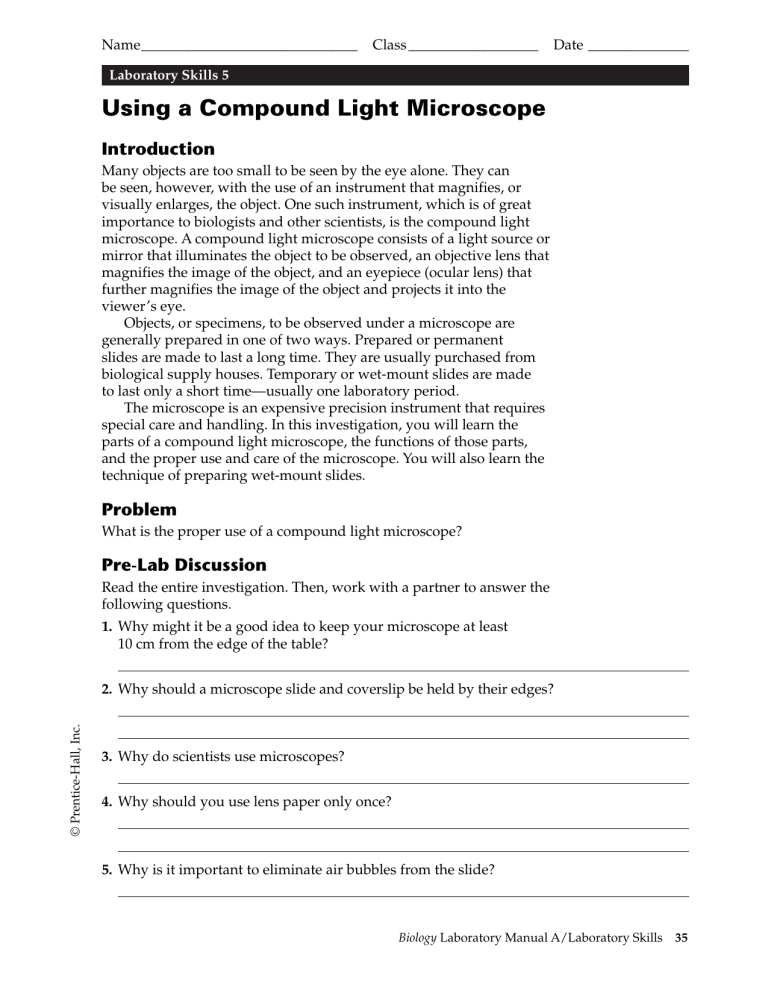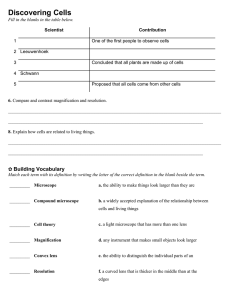
Name______________________________
Class __________________
Date ______________
Laboratory Skills 5
Using a Compound Light Microscope
Introduction
Many objects are too small to be seen by the eye alone. They can
be seen, however, with the use of an instrument that magnifies, or
visually enlarges, the object. One such instrument, which is of great
importance to biologists and other scientists, is the compound light
microscope. A compound light microscope consists of a light source or
mirror that illuminates the object to be observed, an objective lens that
magnifies the image of the object, and an eyepiece (ocular lens) that
further magnifies the image of the object and projects it into the
viewer’s eye.
Objects, or specimens, to be observed under a microscope are
generally prepared in one of two ways. Prepared or permanent
slides are made to last a long time. They are usually purchased from
biological supply houses. Temporary or wet-mount slides are made
to last only a short time—usually one laboratory period.
The microscope is an expensive precision instrument that requires
special care and handling. In this investigation, you will learn the
parts of a compound light microscope, the functions of those parts,
and the proper use and care of the microscope. You will also learn the
technique of preparing wet-mount slides.
Problem
What is the proper use of a compound light microscope?
Pre-Lab Discussion
Read the entire investigation. Then, work with a partner to answer the
following questions.
1. Why might it be a good idea to keep your microscope at least
10 cm from the edge of the table?
© Prentice-Hall, Inc.
2. Why should a microscope slide and coverslip be held by their edges?
3. Why do scientists use microscopes?
4. Why should you use lens paper only once?
5. Why is it important to eliminate air bubbles from the slide?
Biology Laboratory Manual A/Laboratory Skills 35
Materials (per group)
compound light microscope
prepared slide
lens paper
soft cloth (or cheesecloth)
newspaper
microscope slide
coverslip
dissecting probe
dropper pipette
scissors
Safety
Put on a laboratory apron. Always handle the microscope with
extreme care. You are responsible for its proper care and use. Use
caution when handling microscope slides, as they can break easily and
cut you. Never use direct sunlight as a light source for a compound
light microscope. The sunlight reflecting through the microscope could
damage your eye. Be careful when handling sharp instruments.
Observe proper laboratory procedures when using electrical
equipment. Note all safety alert symbols next to the steps in the
Procedure and review the meanings of each symbol by referring to
Safety Symbols on page 8.
Procedure
10X
!
10X
Use the formula to complete the Data Table.
36
Biology Laboratory Manual A/Laboratory Skills
"
100X
Arm
© Prentice-Hall, Inc.
Part A. Care of the Compound Light Microscope
1. Figure 1 shows the proper way to carry a microscope.
Always carry the microscope with both hands. Grasp
the arm of the microscope with one hand and place
your other hand under the base. Always hold the
microscope in an upright position so that the eyepiece
cannot fall out. Place a microscope on your worktable
Base
or desk at least 10 cm from the edge. Position the
microscope with the arm facing you.
2. Notice the numbers etched on the objectives and on the
eyepiece. Each number is followed by an “X” that means Figure 1
“times.” For example, the low-power objective may have
the number “10X” on its side, as shown in Figure 2. That
objective magnifies an object 10 times its normal size. Record the
magnifications of your microscope in the Data Table. The total
magnification of a microscope is calculated by multiplying the
magnification of the objective by the magnification of the eyepiece.
For example:
magnification
magnification
total
!
"
of objective
of eyepiece
magnification
Name______________________________
Class __________________
Date ______________
Figure 2
Data Table
Objective
Magnification
of Objective
Magnification
of Eyepiece
Total
Magnification
Low power
High power
Other
© Prentice-Hall, Inc.
4. Before you use the microscope, clean the lenses of the
objectives and eyepiece with lens paper. Note: To avoid
scratching the lenses, never clean or wipe them with anything other than
lens paper. Use a new piece of lens paper on each lens you clean. Never
touch a lens with your finger. The oils on your skin may attract dust or
lint that could scratch the lens.
Part B. Use of a Compound Light Microscope
1. Look at the microscope from the side. Locate the coarse adjustment knob
that moves the objectives up and down. Practice moving the coarse
adjustment knob to see how it moves the objectives with each turn.
Revolving nosepiece
2. Turn the coarse adjustment so that the low-power
objective is positioned about 3 cm from the stage.
Low-power
Locate the revolving nosepiece. Turn the
objective
nosepiece until you hear the high-power
High-power
objective click into position. See Figure 3. objective
When an objective clicks into position, it
is in the proper alignment for light to
pass from the light source through the
objective into the viewer’s eye. Now turn
the nosepiece until the low-power objective
clicks back into position. Note: Always look
at the microscope from the side when moving an
objective so that the microscope does not hit or
Figure 3
damage the slide.
Biology Laboratory Manual A/Laboratory Skills 37
3. If your microscope has an electric light source, plug in the cord and
turn on the light. If your microscope has a mirror, turn the mirror
toward a light source such as a desk lamp or window. CAUTION:
Never use the sun as a direct source of light. Look through the eyepiece.
Adjust the diaphragm to permit sufficient light to enter the
microscope. The white circle of light you see is the field of view. If
your microscope has a mirror, move the mirror until the field of
view is evenly illuminated.
4. Place a prepared slide on the stage so that it is centered over the
stage opening. Use the stage clips to hold the slide in position. Turn
the low-power objective into place. Look at the microscope from the
side and turn the coarse adjustment so that the low-power objective
is as close as possible to the stage without touching it.
5. Look through the eyepiece and turn the coarse adjustment to move
the low-power objective away from the stage until the object comes
into focus. To avoid eyestrain, keep both eyes open while looking
through a microscope. CAUTION: To avoid moving the objective into
the slide, never lower the objective toward the stage while looking through
the eyepiece.
6. Turn the fine adjustment to bring the object into sharp focus. You
may wish to adjust the diaphragm so that you can see the object
more clearly. In the appropriate space below, draw what you see
through the microscope. Record the magnification.
7. Look at the microscope from the side and rotate the nosepiece until
the high-power objective clicks into position. Look through the
eyepiece. Turn the fine adjustment to bring the object on the slide
into focus. CAUTION: Never use the coarse adjustment when focusing
the high-power objective lens. This could break your slide or damage the
lens. In the appropriate space below, draw what you see through the
microscope. Record the magnification.
High-power
magnification
8. Remove the slide. Move the low-power objective into position.
Part C. Preparing a Wet Mount
1. Use a pair of scissors to cut a letter “e” from a piece of newspaper.
Cut out the smallest letter “e” you can find. Position the “e” on the
center of a clean glass slide.
2. Use a dropper pipette to place one drop of water on the cut piece of
newspaper. See Figure 4B.
38
Biology Laboratory Manual A/Laboratory Skills
© Prentice-Hall, Inc.
Low-power
magnification
Name______________________________
A
Class __________________
Date ______________
B
C
D
Figure 4
3. Hold a clean coverslip in your fingers as shown in Figure 4C. Make
sure the bottom edge of the coverslip is in the drop of water. Use a
dissecting probe to slowly lower the coverslip onto the wet
newspaper. Slowly lowering the coverslip prevents air bubbles from
being trapped between the slide and the coverslip. The type of slide
you have just made is called a wet mount. Practice making a wet
mount until you can do so without trapping air bubbles on the slide.
4. Center the wet mount on the stage with the letter “e” in its normal
upright position. Note: Make sure the bottom of the slide is dry before you
place it on the stage. Turn the low-power objective into position and
bring the “e” into focus. In the appropriate place below, draw the
letter “e” as seen through the microscope. Record the magnification.
5. While looking through the eyepiece, move the slide to the left.
Notice the way the letter seems to move. Now move the slide to the
right. Again notice the way the letter seems to move. Move the slide
up and down and observe the direction the letter moves.
6. Turn the high-power objective into position and bring the letter “e”
into focus. In the appropriate place below, draw the letter “e” as
seen through the microscope. Record the magnification.
© Prentice-Hall, Inc.
Low-power
magnification
High-power
magnification
7. Take apart the wet mount. Clean the slide and coverslip with soap
and water. Carefully dry the slide and coverslip with paper towels
and return them to their boxes.
8. Rotate the low-power objective into position and use the coarse
adjustment to place it as close to the stage as possible without
touching. Carefully pick up the microscope and return it to its
storage area.
Biology Laboratory Manual A/Laboratory Skills 39
Analysis and Conclusions
1. Inferring Why do you place one hand under the base of the
microscope as you carry it?
2. Observing How is the image of an object seen through the highpower objective different from the image seen through the low-power
objective?
3. Observing How does the letter “e” as seen through the microscope
differ from the way an “e” normally appears?
4. Inferring Explain why a specimen to be viewed under the
microscope must be thin.
5. Inferring Why should you never use coarse adjustment when
focusing the high-power objective lens?
Going Further
View some common objects, such as thread or a small piece of a color
photograph from a magazine under the low-power and high-power
objectives of the microscope. Make a drawing for each object. Describe
the appearance of the objects when viewed under a microscope.
40
Biology Laboratory Manual A/Laboratory Skills
© Prentice-Hall, Inc.
6. Drawing Conclusions Suppose you were observing an organism
through the microscope and noticed that it moved toward the
bottom of the slide and then it moved to the right. What does this
tell you about the actual movement of the organism?




